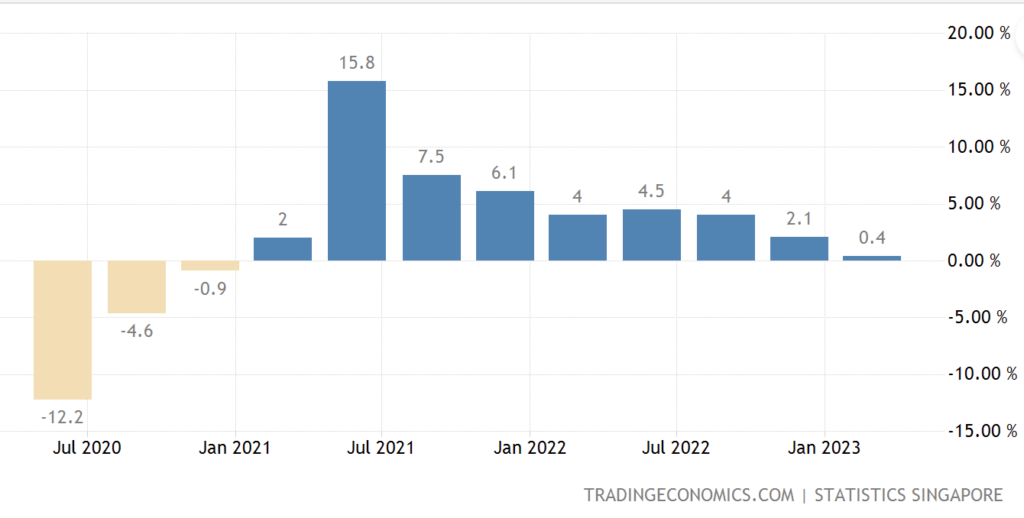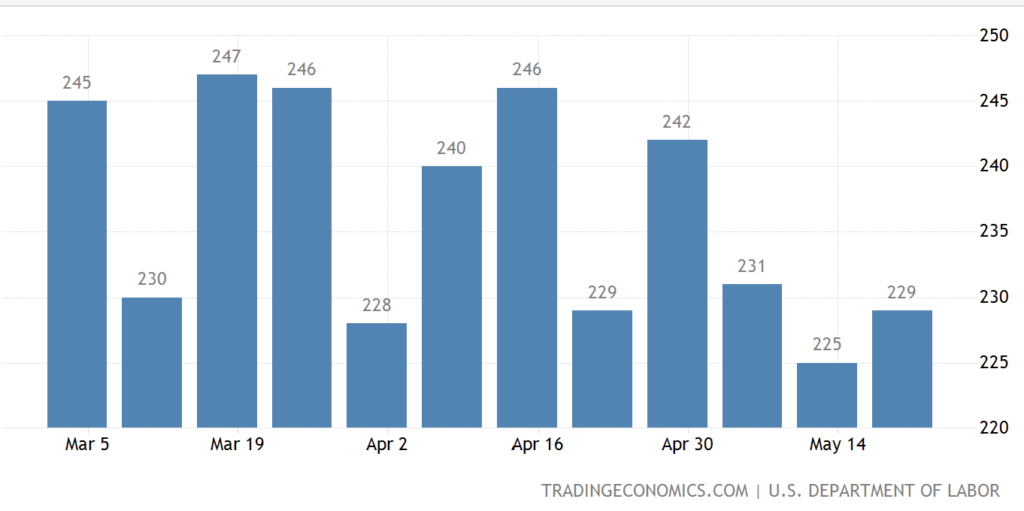#AIEffect #SingaporeGrowth #USJoblessClaims
Topic #1: The AI Effect on S&P500

S&P500 with and without AI Stocks (Till March 17) (Source: Societe Generale)
While the S&P 500 appears to owe its gains this year to the success of Apple and other tech giants, a closer look reveals that without the emergence of artificial intelligence (AI), the index would be in negative territory. A handful of tech stocks with ambitious AI aspirations have played a significant role in driving the S&P 500’s 8% increase. Data reveals that non-AI stocks in the S&P 500 were down approximately 1% from the beginning of the year until mid-May.
Key AI-focused stocks driving the S&P 500’s growth include Nvidia, whose shares have more than doubled this year. Nvidia’s plans to incorporate AI technologies into chips have instilled market confidence in its ability to capture market share and increase prices.
Meta Platforms and Alphabet, on the other hand, are actively working on integrating AI into their advertising offerings, with Meta’s stock doubling this year and Alphabet’s rising by approximately 40%. Microsoft, with a stock surge of over 30% has invested in OpenAI- the developer of ChatGPT, while also incorporating AI into its cloud products.
Collectively, Nvidia, Meta, Alphabet, and Microsoft command a market cap of approximately $5.3 trillion, constituting around 15% of the S&P 500’s total market cap. The success of these AI-driven stocks highlights the significant contribution made by chatbots and AI technologies to the index’s positive performance in the current year.
Topic #2: Singapore economy grows by 0.4%

Singapore GDP growth rate (Source: TRADINGECONOMICS.COM
What Happened?
The Singapore economy grew by 0.4 percent year-on-year in the first quarter, surpassing the earlier estimate of 0.1 percent. However, The Ministry of Trade and Industry (MTI) announced on Thursday that Singapore has maintained its growth forecast for 2023 at 0.5 percent to 2.5 percent. On a quarter-on-quarter seasonally adjusted basis, the economy shrank by 0.4 percent in Q1, reversing the 0.1 percent growth in the previous quarter. Despite these challenges, the MTI does not anticipate Singapore entering a technical recession.
Why did it happen?
The weak performance in Q1 was primarily influenced by contractions in the manufacturing, wholesale trade, and finance and insurance sectors. These contractions were a result of the global economic weakness and the electronics downcycle. MTI’s chief economist, Yong Yik Wei, stated that while the first half of the year may experience flat or low growth numbers, the economy is expected to gradually pick up later in the year, supported by the services sector. The labor market remains tight, with low unemployment rates
What does it mean for the investors?
Singapore’s decision to maintain its growth forecast for 2023 indicates cautious optimism despite the slowdown in the first quarter. The performance of the advanced economies has been more resilient than expected, although their outlook remains weak. This means that investors should closely monitor these factors and adjust their strategies accordingly. The data shows that the domestic aviation and tourism-related sectors show positive prospects, while the manufacturing and trade-related sectors face challenges.
Topic #3: US Initial Unemployment Claims shows strength

Initial jobless claims (Source: TRADING ECONOMICS.COM)
According to the Labor Department’s report on Thursday, initial claims for state unemployment benefits rose by 4,000 to a seasonally adjusted 229,000 in the week ending May 20. Economists surveyed by Reuters had projected 245,000 claims for the latest week. Despite this recent surge, the level of claims remains consistent with a labor market that remains tight.
The low level of unemployment claims aligns with recent data on retail sales, factory production, and business activity, indicating a regained momentum in the economy at the beginning of the second quarter. This resilience in the labor market has been notable, even in the face of aggressive interest rate hikes by the Federal Reserve since March 2022 as the central bank aims to control inflation.
The labor market’s strength is reflected in the ratio of job openings to unemployed people, which stood at 1.6 in March, surpassing the 1.0-1.2 range associated with stable inflation. Employers have been holding onto workers as they faced difficulties finding labor in the aftermath of the COVID-19 pandemic.
While economists anticipate potential layoffs resulting from the effects of interest rate hikes and tighter financial conditions, most expect only a mild recession in the second half of the year. The Federal Reserve’s minutes from its May 2-3 policy meeting revealed that participants acknowledged the tight labor market but predicted slower employment growth due to reduced aggregate demand and tighter credit conditions.
| Index | Level | 1 Week | 1 Month | From Jan 1 2023 |
| S&P 500 (US Stocks) | 4,205 | +0.35% | +1.70% | +9.97% |
| Nasdaq 100 (US Tech Stocks) | 14,298 | +3.57% | +8.65% | +31.63% |
| CSI-300 (Chinese Stocks) | 3,850 | -2.28% | -3.45% | -0.95% |
| Bitcoin (in USD) | 26,699 | -0.58% | -9.44% | +60.79% |
Source: Google Finance, Bloomberg, Yahoo Finance, CNBC, Financial Times, Reuters, Business Times, CNN, Mint



You must be logged in to post a comment.